Mises, Ludwig von. Human Action: A Treatise on Economics
Подождите немного. Документ загружается.

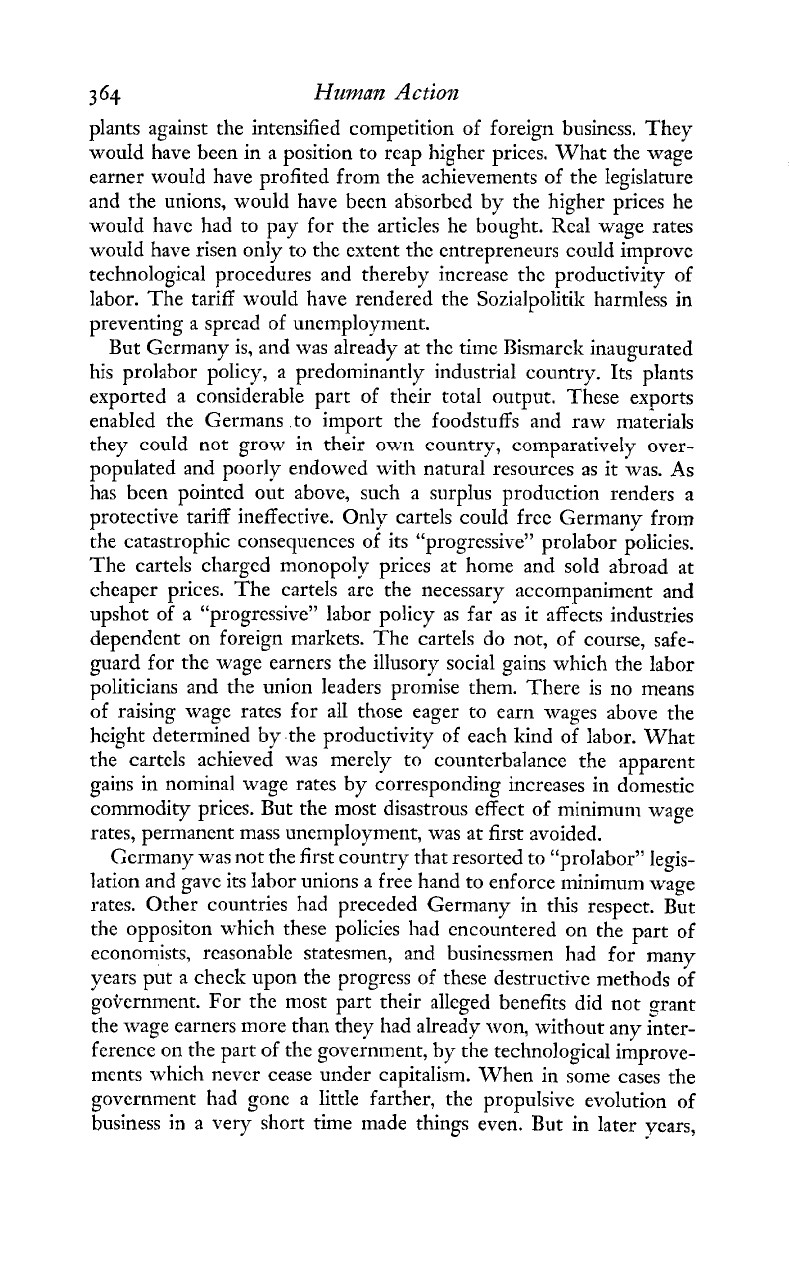
364
Human
Action
plants against the intensified competition of foreign business. They
wouId have been in a position to reap higher prices. What the
wage
earner would have profited from the achievements of the legislature
and the unions, would have been absorbed by the higher prices he
would have had to pay for the articles he bought. Real wage rates
would have risen only to the extent the entrepreneurs could improve
technological procedures and thereby increase the productivity of
labor. The tariff would have rendered the Sozialpolitik harmless in
preventing a spread of unemployment.
But Germany is, and was already at the time Bismarck inaugurated
his prolabor policy, a predominantly industrial country. Its plants
exported a considerable part of their total output. These exports
enabled the Germans to import the foodstuffs and raw materials
they could not grow in their own country, comparatively over-
populated and poorly endowed with natural resources as it was. As
has been pointed out above, such a surplus production renders a
protective tariff ineffective. Only cartels could free Germany from
the catastrophic consequences of its "progressive" prolabor policies.
The cartels charged monopoly prices at home and sold abroad at
cheaper prices. The cartels are the necessary accompaniment and
upshot of a "progressive" labor policy as far as it affects industries
dependent on foreign markets. The carteIs do not, of course, safe-
guard for the wage earners the illusory social gains which the labor
politicians and the union leaders them. There is no means
of raising wage rates for all those eager to earn wages above the
height determined by the productivity of each kind of labor. What
the cartels achieved was merely to counterbalance the apparent
gains in nominal wage rates by corresponding increases in domestic
commodity prices. But the most disastrous effect of minimum wage
rates, permanent mass unemployment, was at first avoided.
Germany was not the first country that resorted to "prolabor" legis-
lation and gave its labor unions a free hand to enforce rninimum wage
rates. Other countries had preceded Germany in this respect.
it
the oppositon w-hich these policies had encountered on the part of
economists, reasonable statesmen, and businessmen had for many
years put a check upon the progress of these destructive methods of
goternment. For the most part their alleged benefits did not grant
..
the wage earners more than they had already won, without any inter-
ference on the part of the government, by the technological improve-
ments which never cease under capitalism. When in some cases the
government had gone a little farther, the propulsive evolution of
business in a very short time ~nade things even. Rut in later years,
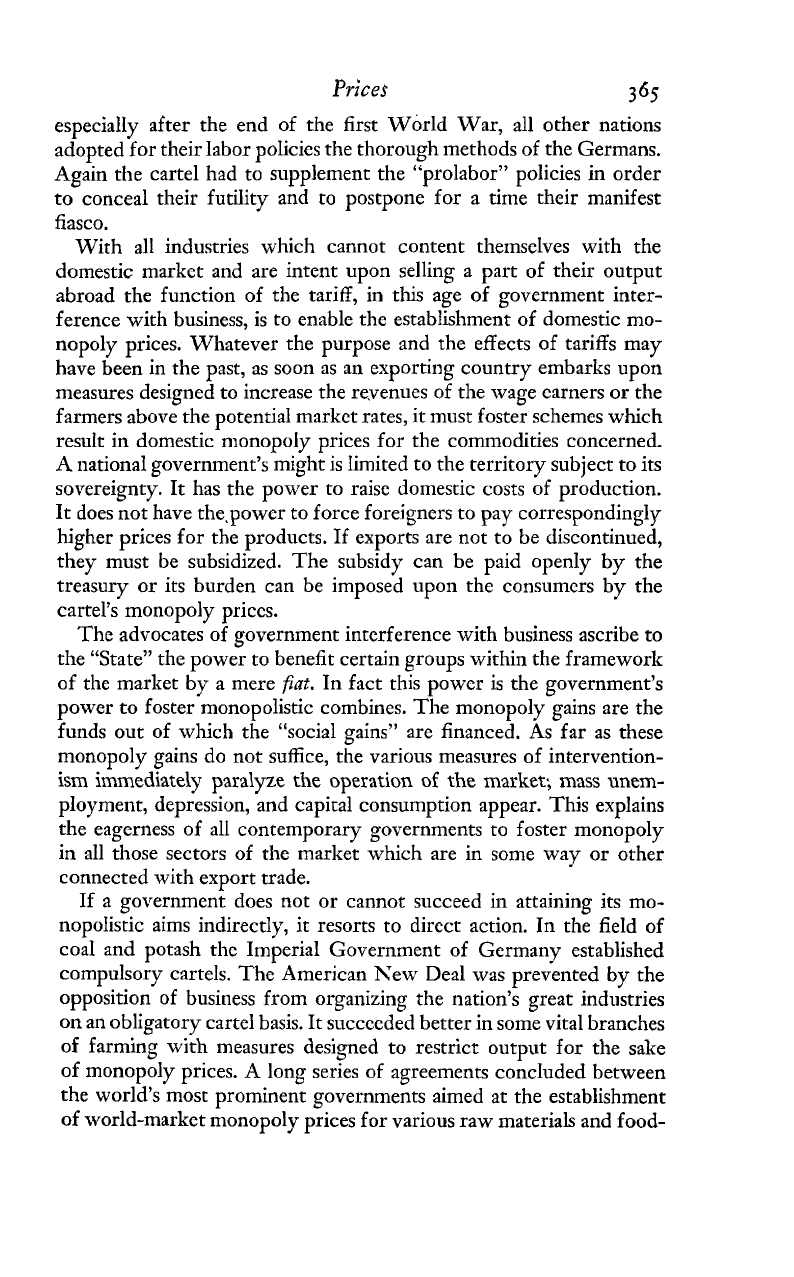
Prices
365
especially after the end of the first World War, all other nations
adopted for their labor poIicies the thorough methods of the Germans.
Again the cartel had to supplement the "prolabor" policies in order
to conceal their futility and to postpone for a time their manifest
fiasco.
With all industries which cannot content themselves with the
domestic markct and are intent upon selling a part of their output
abroad the function of the tariff, in this age of government inter-
ference with business, is to enable the establishment of domestic mo-
nopoly prices. Whatever the purpose and the effects of tariffs may
have been in the past, as soon as an exporting country embarks upon
measures designed to increase the re~venues of the wage earners or the
farmers above the potential market rates, it must foster schemes which
result in domestic nlonopoly prices for the comn~odities concerned.
A
national government's might is Iimited to the territory subject to its
sovereignty. It has the power to raise domestic costs of production.
It does not have the,power to force foreigners to pay correspondingly
higher prices for the products. If exports are not to be discontinued,
they must be subsidized. The subsidy can be paid openly by the
treasury or its burden can be imposed upon the consumers by the
cartel's monopoly prices.
The advocates of government interference with business ascribe to
the "State" the power to benefit certain groups within the framework
of the market by a mere
fiat.
In fact this power is the government's
power to foster monopolistic combines. The monopoly gains are the
funds out of which the "social gains" are financed. As far as these
monopoly gains do not suffice, the various measures of intervention-
ism
immediately paralyze the operation of the market;
mass
unem-
ployment, depression, and capital consumption appear. This explains
the eagerness of all contemporary governments to foster monopoly
in all those sectors of the market which are in some way or other
connected with export trade.
If
a
government does not or cannot succeed
in
attaining its mo-
nopoIistic aims indirectly, it resorts to direct action. In the field of
coal and potash the Imperial Government of Germany established
compulsory cartels. The American New Deal was prevented by the
opposition of business from organking the nation's great industries
on an obligatory carte1 basis. It succeeded better in some vital branches
of farming with measures designed to restrict output for the sake
of monopoly prices.
A
long series of agreements concluded between
the world's most prominent governments aimed at the establishment
of world-market monopoly prices for various raw materials and food-
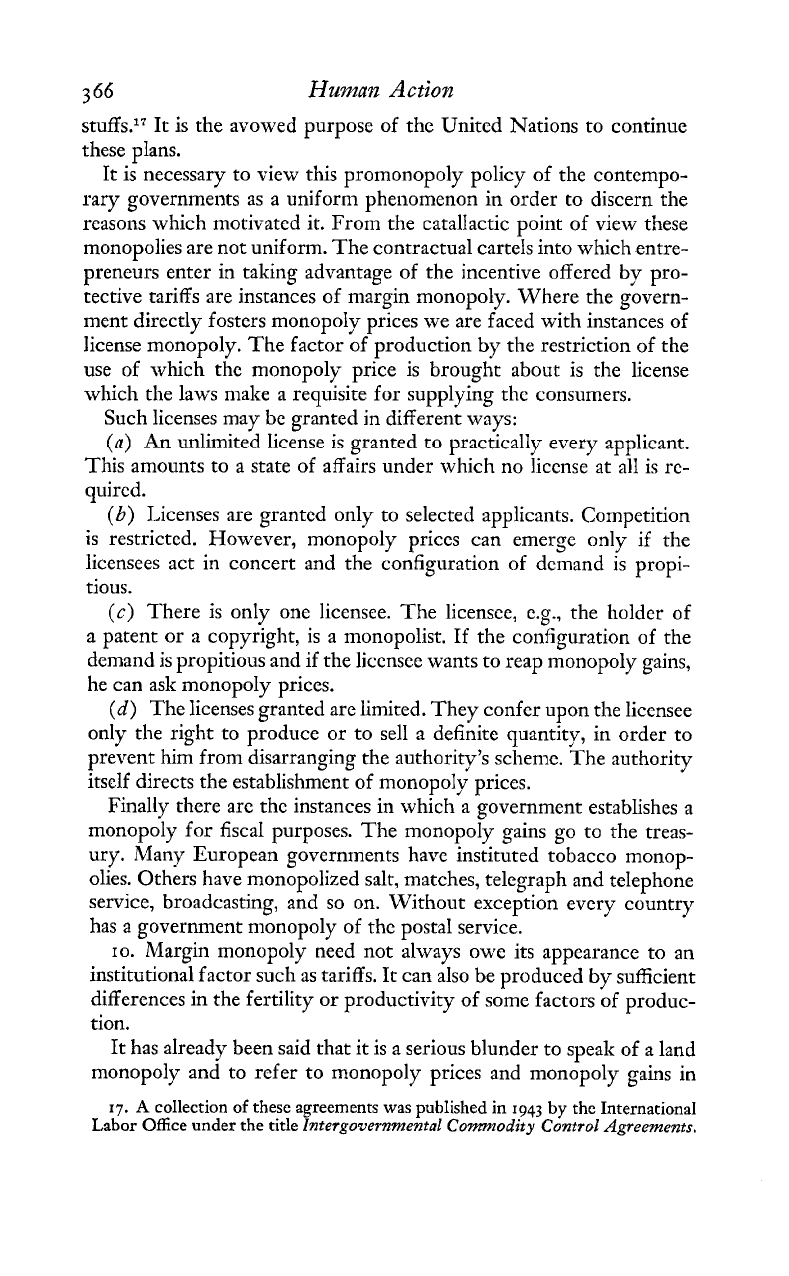
366
Human
Action
stuffs.17 It is the avowed purpose of the United Nations to continue
these plans.
It is necessary to view this promonopoly policy of the contempo-
rary governments as a uniform phenomenon in order to discern the
reasons which motivated it. From the catalIactic point of view these
monopolies are not uniform. The contractual cartels into which entre-
preneurs enter in taking advantage of the incentive offered by pro-
tective tariffs are instances of margin monopoly. Where the govern-
ment directly fosters monopoly prices we are faced with instances of
license monopoly. The factor of production by the restriction of the
use of which the monopoly price is brought about is the license
which the laws make a requisite for supplying the consumers.
Such licenses may be granted in different ways:
(a)
An
unlimited license is granted to practically every applicant.
This amounts to a state of affairs under which no license at all is re-
quired.
(b)
Licenses are granted only to selected applicants. Competition
is restricted. However, monopoly prices can emerge only if the
licensees act in concert and the configuration of demand is propi-
tious.
(c)
There is only one licensee. The licensee, e.g:, the holder of
a patent or a copyright, is a monopolist. If the
configuration
of the
demand is propitious and if the licensee wants to reap monopoly pins,
he can ask monopoly prices.
(d)
The licenses granted are limited. They confer upon the licensee
only the right to produce or to sell a definite quantity, in order to
prevent him from disarranging the authority's schen~e. The authority
itself directs the establishment of monopoly prices.
Finally there arc thc instances in which a government estabIishes a
monopoly for fiscaI purposes. The monopoly gains go to the treas-
ury. Many European governments have instituted tobacco monop-
olies. Others have monopolized salt, matches, telegraph and telephone
service, broadcasting, and so on. Without exception every country
has a government n~onopoly of the postal service.
10.
Margin monopoly need not always owe its appearance to an
institutional factor such as tariffs. It can also be produced by sufficient
differences in the fertility or productivity of some factors of produc-
tion.
It has already been said that it is
a
serious blunder to speak of a land
monopoly and to rcfer to monopoly prices and monopoly gains in
17.
A
collection of these agreements was published
in
1943
by
the International
Labor Office under the title
intergovernmental
Comodity Control
Agreements.

Prices
367
explaining the prices of agricultural products and the rent of land.
As far as history is confronted with instances of monopoly prices
for agricultural products, it was license monopoly fostered by govern-
ment decree. However the
acknowledgment
of these facts does not
mean that differences in the fertility of the soil could never bring about
monopoly prices. If the difference'between the fertility of the poorest
soil still tilled and the richest fallow fields available for an expansion
of production were so great as to enable the owners of the already
exploited soil to find an advantageous monopoly price within this
margin, they could consider restricting production by concerted
action in order to reap monopoly prices. But it is a fact that physical
conditions in agriculture do not comply with these requirements.
It
is precisely
on
account
of
this
fact that farmers longing for mo-
nopoly prices do not resort to spontaneous action but ask for the in-
terference of governments.
In various branches of mining conditions are often more propitious
for the emergence of monopoly prices based on margin monopoly.
r
I.
It has been asserted again and again that the economies of big-
scale production have generated a tendency toward monopoly prices
in the processing industries. Such a monopoly would be called in our
terminology
a
margin monopoly.
Before entering into a discussion of this topic one must clarifv the
role an increase or decrease in the unit's average cost of production
plays in the considerations of a monopolist searching for the most
advantageous monopoly price. We consider a case in which the owner
of
a
monopolized complementary factor of production, e.g., a patent,
at the same time manufactures the product
p.
If the average cost of
production of one unit of
p,
without any regard to the patent, de-
creases with the increase in the quantity produced, the monopolist
must weigh this against the gains expected from
the
restriction of
output. If on the other hand cost of production per unit decreases
with the restriction of total production, the incentive to embark upon
monopolistic restraint is augmented.
It
is obvious that the mere fact
that big-scale production tends as a nile to lower average costs of
production is in itself not
a
factor driving toward the emergence
of
monopoly prices. It is rather a checking factor.
What those who blame the economies of big-scale production for
the spread of monopoly prices are trying to say is that the higher
efficiency of big-scale production makes it difficult or even impossible
for small-scale plants to compete successfuIly.
A
big-scale plant could,
they believe, resort to monopoly prices with impunity because small
business is not in a position to challenge its monopoly. Now, it is cer-
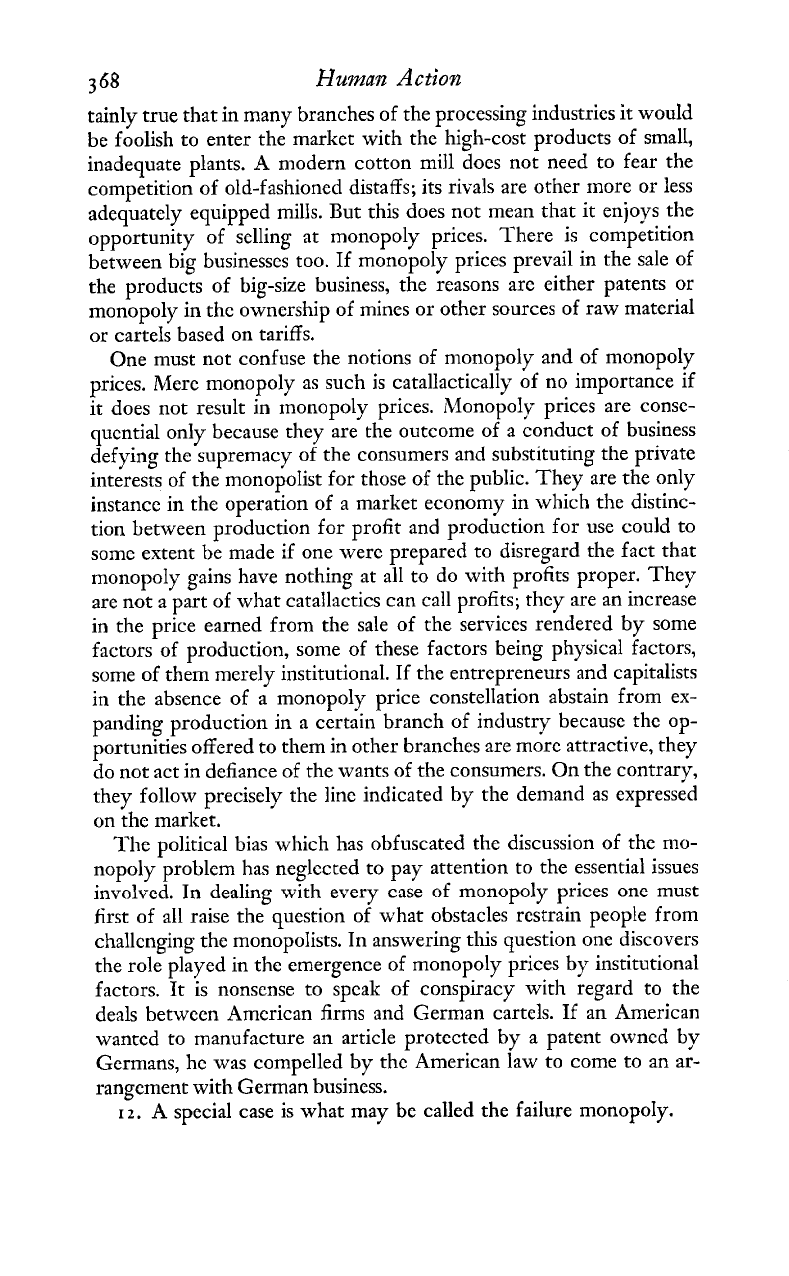
368
Human
Action
tainly true that in many branches of the processing industries it would
be foolish to enter the market
with
the high-cost products of smal1,
inadequate plants. A modern cotton mill does not need to fear the
competition of old-fashioned distaffs; its rivals are other more or less
adequately equipped mills. But this does not mean that it enjoys the
opportunity of selling at monopoly prices. There is competition
between big businesses too. If monopoly prices prevail in the sale of
the products of big-size business, the reasons arc either patents or
monopoly in thc ownership of mines or other sources of raw material
or cartels based on tariffs.
One must not confuse the notions of n~onopoly and of monopoly
prices. Merc monopoly as such is catallactically of no importance if
it does not result in monopoly prices. Monopoly prices are conse-
quential only because they are the outcome of a conduct of business
defying the supremacy of the consumers and substituting the private
interests of the monopoIist for those of thc public. They are the only
instance in the operation of a market economy in which the distinc-
tion between production for profit and production for use could to
some extent be made if one were prepared to disregard the fact that
monopoly gains have nothing at all to do with profits proper. They
are not a part of what catallactics can call profits; they are an increase
in the price earned from the sale of the services rendered by some
factors of production, some of these factors being physical factors,
some of them merely institutional. If the entrepreneurs and capitalists
in the absence of a monopoly price constellation abstain from ex-
panding production in a certain branch of industry because the op-
portunities offered to them in other branches are more attractive, they
do not act in defiance of the wants of the consumers. On the contrary,
they follow precisely the line indicated by the denland as expressed
on the market.
The political bias which has obfuscated the discussion of the
mo-
nopoly problem has neglected to pay attention to the essential issues
;-x~nl--J.
1-
A-ol;-m
~xAth
~T-OYTT
POCP
of
mmopo!y
9rices
ane
mnsc
IIIVIIIVCLL
111
UWllllS
V"1L1.
U"
rl
J
----
first of all raise the question of what obstacles restram people from
challcnging the monopoIists. In answering this question one discovers
the role played in the emergence of monopoly prices by institutional
factors. It is nonsense to spcak of conspiracy with regard to the
deals between American firms and German cartels. If an American
wanted to manufacture an article protected by a patent owned by
Germans, he was compelled by the American law to come to an ar-
rangement with German business.
I
2.
A special case is what may be called the failure monopoly.

Prices
In the past capitalists invested funds in a plant designed for the
production of the article
p.
Later events proved the investment
;I
failure, The prices which can be obtained in selling
p
are so low that
the capital invested in the plant's inconvertible equipment does not
yield a return. It is lost. However, these prices arc high enough to
yield a reasonable return for the variable capital to be employed for
the current production of
p.
If the irrevocable loss
of
the capital in-
vested in the inconvertible equipment is written off on the books and
all corresponding alterations arc made in the accounts, the reduced
capital working in the conduct of the business is by and large so
profitable that it wouId be a new mistake to stop production alto-
gether. The plant works at full capacity producing the quantity
q
of
p
and selling the unit at the price
s.
But conditions may be such that it is possible for the enterprise
to reap a monopoly gain by restricting output to
q/2
and selling the
unit of
p
at the price
3
s.
Then the capital invested in the inconvertible
equipment no longer appears completely lost. It yields a modest re-
turn, namely, the monopoly gain.
This enterprise now sells at monopoly prices and reaps monopoly
gains although the total capital invested yields little when compared
with what the investors would have earked if they had invested in
other lines of business. The enterprise withholds from the market
the services which the unused production capacity of its durable
equipment could render and fares better than
it
would by producing
at full capacity. It defies the order3 of the public. The public would
have been in better position if the investors had avoided the mistake
of immobilizing a part of their capital in the production of
p.
They
would, of course, not get any
p.
But they would instead obtain those
articles which they miss now because the capital required for their
production has been wasted
in
the construction of an aggregate for
the production
of
p.
However, as things are now after this irreparable
fault has been committed, the%. want to get more of
p
and are ready
to pay for it what is now its potential competitive market price,
namely,
s.
They do not approve, as conditions are now, the action of
the enterprise in withholding an amount of variable capital from
employment for the production of
p.
This amount certainly does not
remain unused. It goes into other lines of business and produces there
something else, namely.
m.
But as conditions are now, the consumers
would prcfer an increase of thc available quantity of
p
to an increase
in the available quantity of
727.
The proof is that inthe absence of a mo-
nopoIistic restriction of the capacity for the production of
p,
as it is
under given conditions, the profitability of a production of the quan-
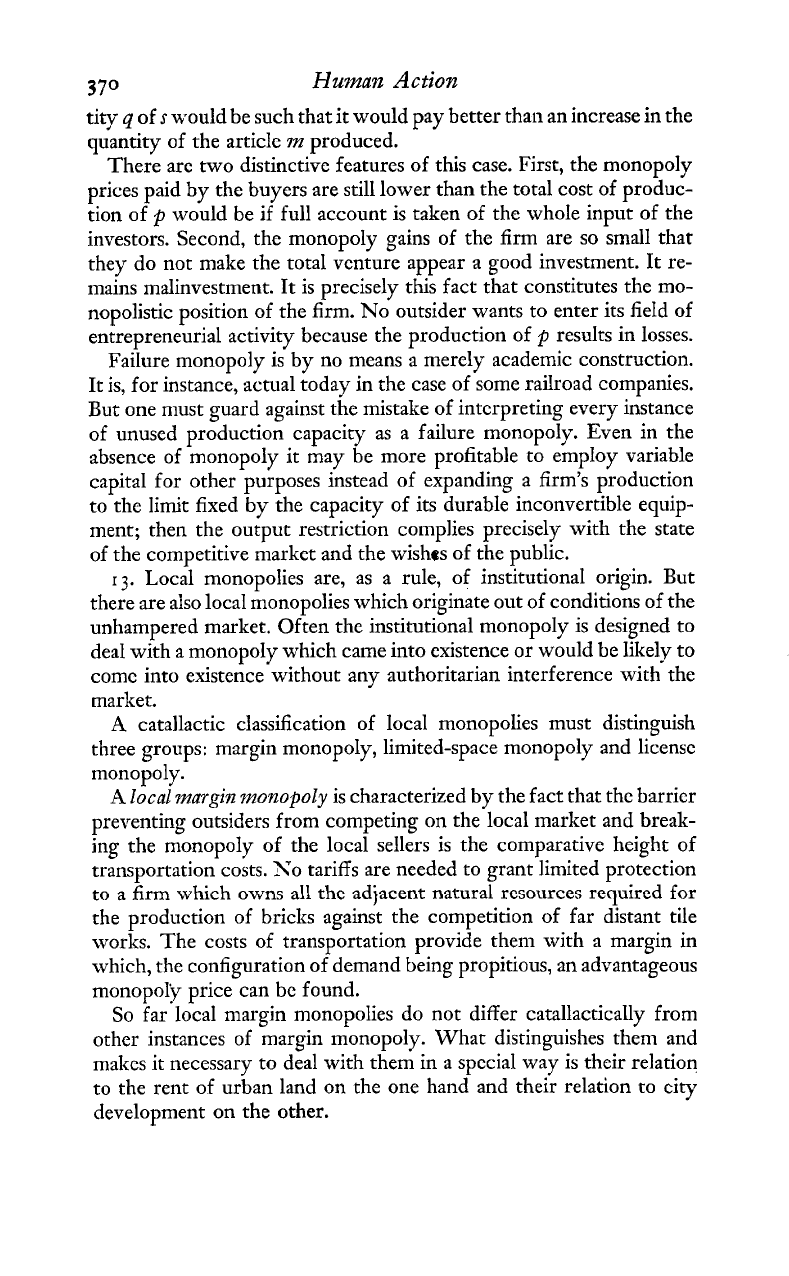
370
Human
Action
tity
q
of
s
would be such that it would pay better than an increase in the
quantity of the article
7n
produced.
There arc two distinctive features of this case. First, the monopoly
prices paid by the buyers are still lower than the total cost of produc-
tion of
p
would be if full account is taken of the whole input of the
investors. Second, the monopoly gains of the firm are so small that
they do not make the total venture appear a good investment. It re-
mains malinvestment. It is precisely this fact: that constitutes the mo-
nopolistic position of the firm. No outsider wants to enter its field of
entrepreneurial activity because the production of
p
results in losses.
Failure monopoly is by no means a merely academic construction.
It is, for instance, actual today in the case of some railroad companies.
But
one must guard against the mistake of interpreting every instance
of unused production capacity as a failure monopoly. Even in the
absence of monopoly it may be more profitable to employ variable
capital for other purposes instead
of
expanding a firm's production
to the limit fixed by the capacity of its durable inconvertible equip-
ment; then the output restriction complies precisely with the state
of the competitive market and the wishes of the public.
13.
Local monopolies are, as a rule, of institutional origin. But
there are also local monopolies which originate out of conditions of the
unhampered market. Often the institutional monopoly is designed to
deaI with a monopoly which came into existence or would be likely to
come into existence without any authoritarian interference with the
market.
A
catallactic classification of local monopolies must distinguish
three groups: margin monopoIy, limited-space monopoly and license
monopoly.
A
local margin monopoly
is characterized by the fact that the barricr
preventing outsiders from competing on the local market and break-
ing the monopoly of the local sellers is the comparative height of
transportation costs. So tariffs are needed to grant limited protection
c-
,-
..,L'
1..
-7.7-.-
+La
n
:fin,,+
,n+r7m
rnrnrrn.nr rn".l;ma
4-r
LU
a
filu~
WLI~CLI uwua
a!!
u1L adja&CuL ImLula! lCauLLLLC.7 1C.t UILLu
1
the production of bricks against the competition of far distant tile
works. The costs of transportation provide them with a margin in
which, the configuration of demand being propitious, an advantageous
monopob price can be found.
So far'local margin monopolies do not differ catallactically from
other instances of margin monopoly. What distinguishes them and
makes it necessary to deal with them in a special way is their relation
to the rent of urban land on the one hand and their relation to city
development on the other.
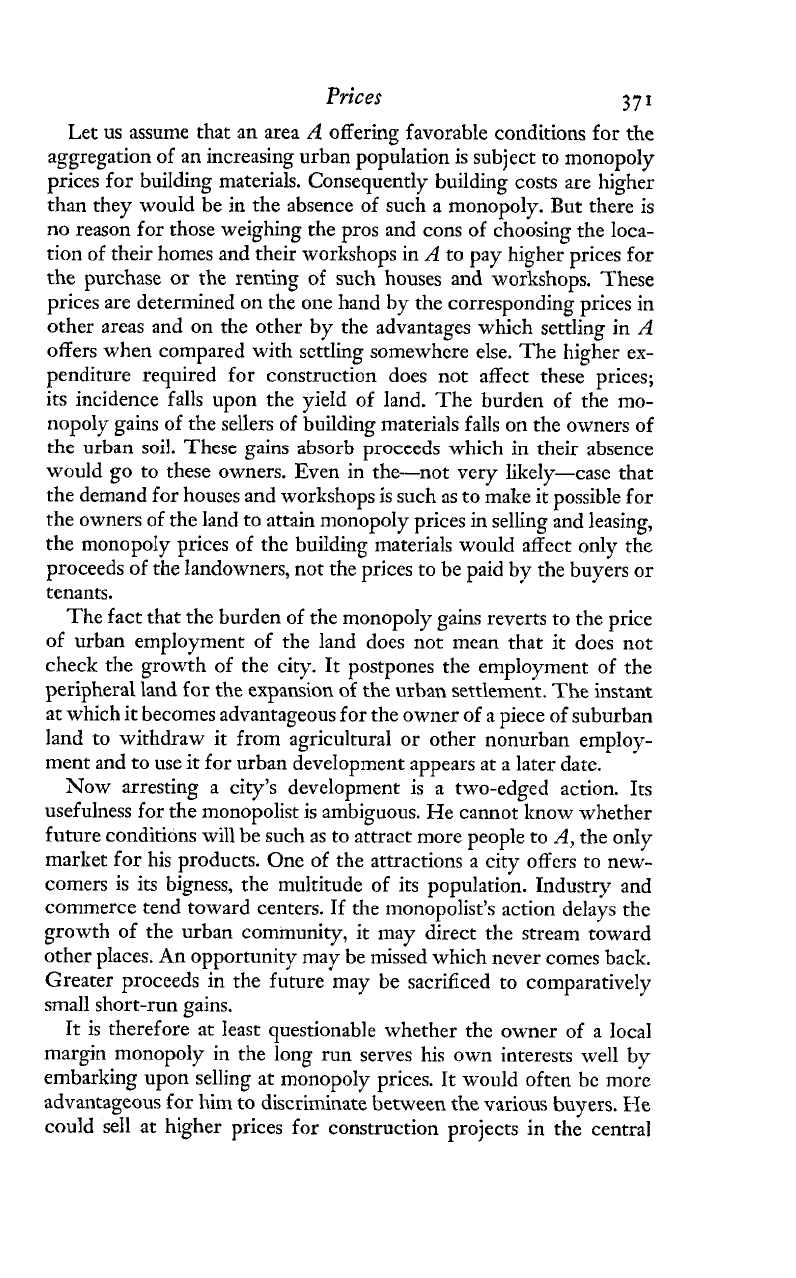
Prices
371
Let us assume that an area
A
offering favorable conditions for the
aggregation of an increasing urban population is subject to monopoly
prices for building materials. Consequently building costs are higher
than they would be in the absence of such a monopoly. But there is
no reason for those weighing the pros and cons of choosing the loca-
tion of their homes and their workshops in
A
to pay higher prices for
the purchase or the renting of such houses and workshops. These
prices are determined on the one hand hy the corresponding prices in
other areas and on the other by the advantages which settling in
A
offers when compared with settling somewhere else. The higher ex-
penditure required for construction does not affect these prices;
its incidence falls upon the yield of land. The burden of the mo-
nopoly gains of the sellers of building materials falls on the owners of
the urban soil. These gains absorb proceeds which in their absence
would go to these owners. Even in the-not very likely-case that
the demand for houses and workshops is such as to make it possible for
the owners of the land to attain monopoly prices in selling and leasing,
the monopoIy prices of the building materials would affect only the
proceeds of the landowners, not the prices to be paid
by
the buyers or
tenants.
The fact that the burden of the monopoly gains reverts to the price
of urban employment of the land does not mean that it does not
check the growth of the city. It postpones the employment of the
peripheral land for the expansion of the urban settlement. The instant
at which it becomes advantageous for the owner of a piece of suburban
land to withdraw it from agricultural or other nonurban employ-
ment and to use it for urban development appears at a later date.
Now arresting a city's development is a two-edged action. Its
usefulness for the monopolist is ambiguous. He cannot know whether
future conditions will be such as to attract more people to
A,
the only
market for his products. One of the attractions a city offers to new-
comers is its bigness, the multitude of its population. Industry and
commerce tend toward centers. If the monopolist's action delays the
growth of the urban community, it may direct the stream toward
other places. An opportunity may be missed which never comes back.
Greater proceeds in the future may be sacrificed to comparatively
small short-run gains.
It is therefore at least questionable whether the owner of a local
margin monopoly in the long run serves his own interests well by
embarking upon selling at monopoly prices. It would oftcn bc more
advantageous for him to discriminate between the various buyers.
He
could sell at higher prices for construction projects in the central

372
Human
Action
parts of the city and at lower prices for such projects in peripheral
districts. The range of local margin monopoly is more restricted than
is generally assumed.
Limited-space mompoly is the outcome of the fact that physical
conditions restrict the field of opcration in such a way that only one
or
a
few enterprises can enter it. Monopoly emerges when there is
only one enterprise in the field or when the few operating enter-
prises combine for concerted action.
It is sometimes possible for two competing trolley companies to
operate in the same streets of a city. There were instances in which
two or even more companies shared in supplying the residents of
an area with gas, electricity, and telephone service. But even in such
exceptional cases there is hardly any real competition. Conditions
suggest to the rivals that they combine at least tacitly. The narrow-
ness of the space results, one way or another, in monopoly.
In practice limited-space monopoly is closely connected with
license monopoly. It is practically impossible to enter the field with-
out an understanding with the local authorities controlling the streets
and their subsoil.
Even
in the absence of laws requiring a franchise
for the
establishment
of public utility services, it would be necessary
for the enterprises to come to an agreement with the municipal
authorities. Whether or not such agreements are to be lcgally de-
scribed as franchises is unimportant.
Monopoly, of course, need not result in monopoly prices. It de-
pends on the special data of each case whether or not a monopolistic
public utility company could resort to monopoly prices. But there
are certainly cases in which it can. It may be that the company is
ill-advised in choosing a monopoly-price policy and that it would bet-
ter serve its long-run interests by lower prices. But there is no
guarantee that a monopolist will find out what is most advantageous
for him.
One must realize that limited-space monopoly may often result in
monopoly prices. In this case we are confronted with a situation in
which the market process does not accomplish its democratic func-
tion.18
Private enterprise is very unpopular with our contemporaries. Pri-
vate ownership of the means of production is especially disliked in
those fields in which limited-space n~onopoly emerges even if the
company does not charge monopoly prices and even if its business
yields only small profits or results in losses.
A
"public utility" com-
pany is in the eyes of the interventionist and socialist pcjli&ians a
18.
About
the significance
of
this
fact
see
below,
pp.
676678.
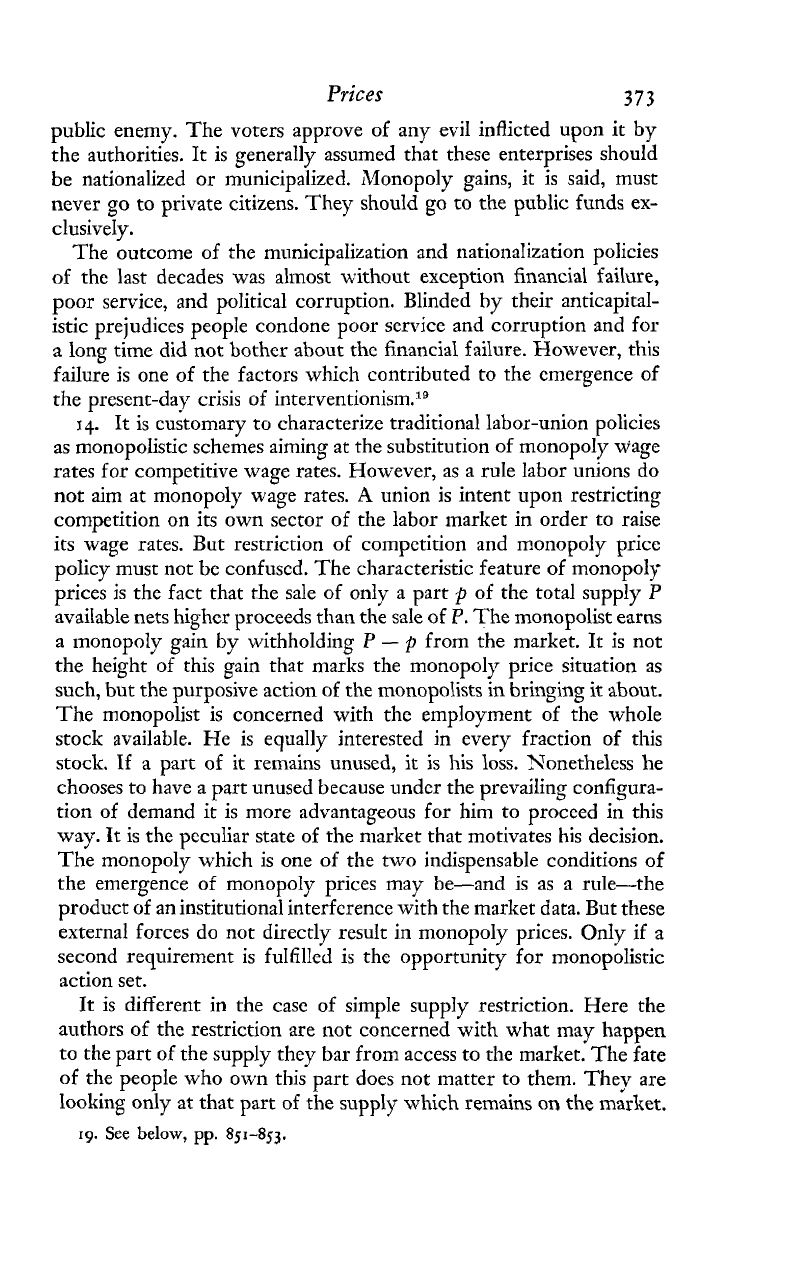
Prices
public enemy. The voters approve of any evil inflicted upon it by
the authorities. It is generally assumed that these enterprises shouid
be nationalized or municipalized. Monopoly gains, it is said, must
never go to private citizens. They should go to the public funds ex-
clusiveIy.
The outcome of the municipalization and nationalization policies
of the last decades was almost without exception financial failare,
poor service, and political corruption. Blinded by their anticapital-
istic prejudices people condone poor service and corruption and for
a
long time did not bother about the financial failure. However, this
failure is one of the factors which contributed to the emergence of
the present-day crisis of interventionism,'"
14.
It is customary to characterize traditional labor-union policies
as monopolistic schemes aiming at the substitution of monopoly wage
rates for competitive wage rates. However, as a rule labor unions do
not aim at monopoly wage rates.
A
union is intent upon restricting
competition on its own sector of the labor market in order to raise
its wage rates. But restriction of competition and monopoly price
policy must not be confused. The characteristic feature of monopoly
prices is the fact that the sale of only a part
p
of the total supply
P
available nets higher proceeds than the sale of
P.
The monopolist earns
a monopoly gain
by
withholding
P
-
p
from the market. It
is
not
the height of this gain that marks the monopoly price situation as
such, but the purposive action of the monopolists in bringing
it
about.
The monopolist is concerned with the employment of the whole
stock available. He is equally interested in every fraction of this
stock.
Tf
a part of it remains unused, it
is
his loss. Xonetheless he
chooses to have a part unused because under the prevailing configura-
tion of demand it is more advantageous for him to proceed in this
way.
It
is the peculiar state of the market that motivates his decision.
The monopoly which is one of the two indispensable conditions of
the emergence of monopoly prices may be-and is as a rule-the
product of an institutional interference with the market data. But these
external forces do not directly result in nlonopoly prices. Only if a
second req~iirement is fulfilled is the opportunity for monopolistic
action set.
It
is different in the case of simple supply restriction. Here the
authors of the restriction are not concerned with what may happen
to the part of the supply they bar from access to the market. The fate
of the people who own this part does not matter to them. They are
looking only at that part of the supply which remains
on
the market,
rg.
See
below,
pp.
851-853.
